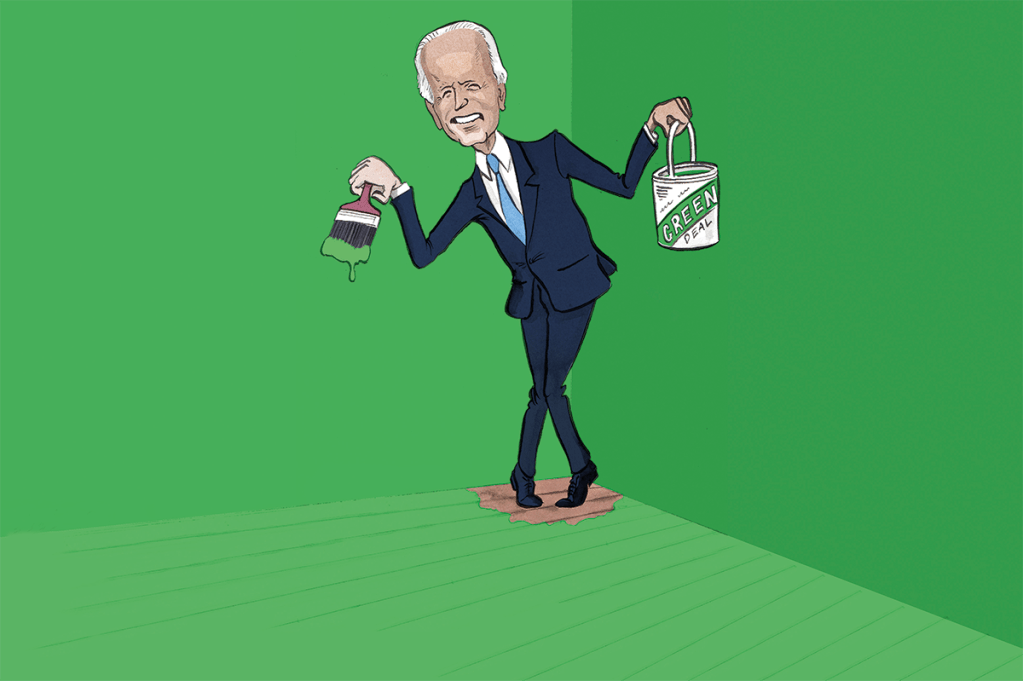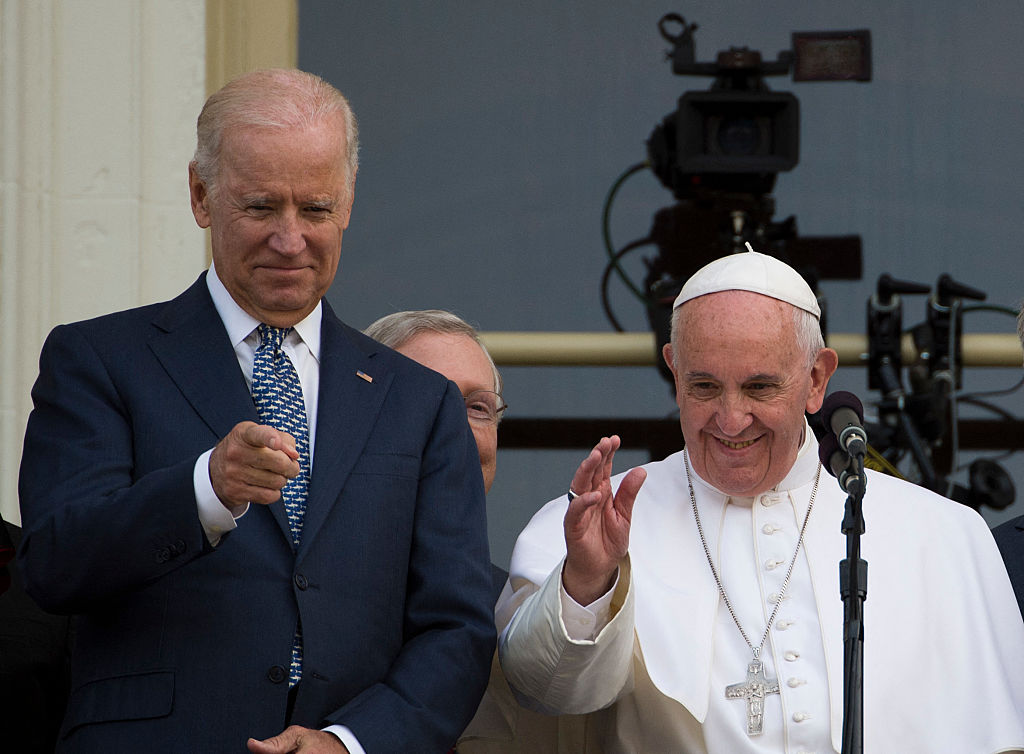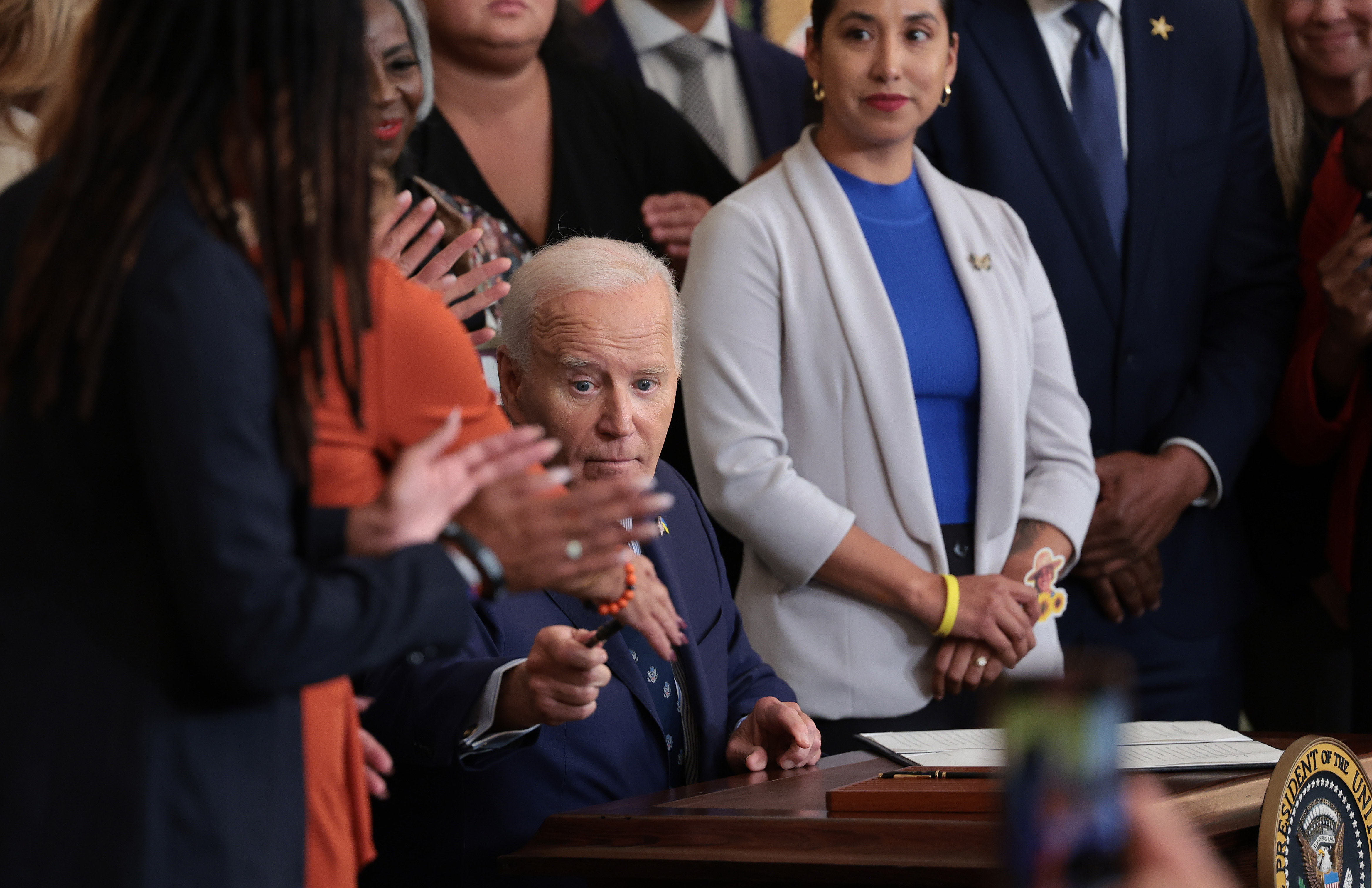“For too long, we’ve failed to use the most important word when it comes to meeting the climate crisis,” President Biden declared in his presidential address to Congress in April 2020. “Jobs. Jobs. Jobs.” Investments in jobs and infrastructure, the president pleaded, have often had bipartisan support in the past. In November, he got nineteen Republican senators to vote for his $1 trillion infrastructure bill, but the main planks of Biden’s climate plan were in the $2.2 trillion Build Back Better Act. The House passed it in November, only for it to fail in the Senate, thanks to opposition from the most powerful man in Washington, at least when it comes to passing legislation.
Senator Joe Manchin represents West Virginia, a state where the energy wars have already inflicted severe loss on Democrats. In 1996, West Virginia reelected Bill Clinton by a near fifteen-point margin over Bob Dole. Four years later, Al Gore lost the state by six points — and the presidency with it. After thirty-six years in the Senate, Biden should have known the power of a state that, though poor, has outsized influence: for twelve of those thirty-six years, Robert Byrd of West Virginia was the leader of the Senate Democrats.
When Nancy Pelosi became Speaker in 2007, she attempted to green the Capitol power plant. Situated a few blocks from the Capitol, the plant supplies the Capitol Hill complex with electricity. It burns 40,000 tons of coal a year, some of it supplied under long-term contracts from the Kanawha Eagle mine, located in, you’ve guessed it, West Virginia. Pelosi’s plan was defeated by Robert Byrd and Kentucky’s Mitch McConnell – “two senators from two of the greatest coal-producing states in America,” McConnell said.
Manchin was West Virginia’s governor when Byrd died in 2010. Though West Virginia was trending increasingly Republican in presidential elections, Manchin won Byrd’s seat. His campaign material included an ad in which Manchin promised to take aim at Obama’s cap-and-trade bill which, if it had been passed, would have established an emissions-trading scheme similar to the European Union’s. Manchin opposed raising the cost of burning coal “because it’s bad for West Virginia,” and won by a ten-point margin. Both of Manchin’s successors in the governor’s mansion were elected as Democrats, but months into the Trump presidency, the current governor, Jim Justice II, told West Virginians he was switching. “I can’t help you anymore being a Democrat governor,” he declared.
The financial interests of West Virginia’s political leaders are substantially aligned with its economic interests. In 2009, Jim Justice II became West Virginia’s only native-born billionaire after selling a collection of his West Virginia coal mines to Mechel, a Russian energy company, for an estimated $500 million in cash plus stock worth $700 million. Falling coal prices subsequently soured the deal, and Mechel forced Justice to buy back the stock at a discount. After Biden’s election — only Wyoming voted more heavily for Trump than West Virginia — Justice said that “we’d be blowing our legs off” to believe the nation could do without coal and natural gas. Manchin’s family also has an interest in coal: they own a coal brokerage he started up in the late 1980s. West Virginia’s voters don’t seem to mind.
Supporters of the green energy transition and Biden’s climate policies see West Virginia’s attachment to coal, and Manchin’s resistance to Biden, as less about jobs and economics and more about personal interest and “coal culture.” It’s a take that recalls Barack Obama’s remark about blue-collar voters in the de-industrialized Midwest “clinging to guns and religion.”
Mining jobs are not some distant memory in West Virginia. After a long decline, jobs in mining and logging in the state rose sharply in the first decade of the century, from 21,600 employees in February 2002 to a peak of 35,700 at the end of 2011. After falling back to 16,400 in July 2020, the latest count shows a rise to 19,900 in October 2021 — and it’s likely to rise further given strong coal prices. In 2020, West Virginia produced more coal than any other state apart from Wyoming. The most recently available monthly data — for August 2021 — shows that coal accounted for 93.3 percent of West Virginia’s electricity production. Wind and solar accounted for less than 1 percent.
One thing the coal-as-cultural-artifact theoreticians don’t see is that, thanks to fracking, West Virginia has become a coal and gas state. West Virginia is at the southwestern end of the Marcellus shale formation, which extends northeastwards from West Virginia into eastern Ohio, Pennsylvania and upstate New York. In the ten years after 2010, West Virginia’s production of natural gas rose nearly tenfold, making the state the US’s fifth-biggest energy producer. Indeed, in 2019, its natural gas output in BTU terms was 7.3 percent higher than its coal output.
Fracking was slow to make an impact in Washington. For the first three years of his presidency, Barack Obama ignored the fracking revolution that was turning America into a hydrocarbon superpower and transforming the economies of states such as West Virginia and Pennsylvania. But in 2012, with a tough reelection fight ahead of him, fracking was too good to ignore. “Right now — right now, American oil production is the highest that it’s been in eight years,” Obama boasted in his 2012 State of the Union address. In 2020, Obama reminded us that under his administration, “we relied less on foreign oil than in any of the past sixteen years.” The contrast between Obama and Biden, who is imploring OPEC and Russia to increase their oil output to solve America’s energy supply crisis, could hardly be greater.
Some of the Biden administration’s leading lights on energy and climate are Obama alums, notably climate envoy John Kerry and national climate advisor Gina McCarthy. But when it comes to energy, this is far from being Obama’s third term. Compared to Obama the pragmatist, Biden is doctrinaire and inflexible. Obama wanted credit for fracking. Public research dollars, Obama claimed, had helped develop the technologies to extract natural gas from shale. This, Obama said, reminded us that “government support is critical in helping get new energy ideas off the ground.” Under Obama, it was “You didn’t build that.” With Biden, it’s “You won’t build that — and neither will the federal government.”
For Manchin, the politics are straightforward. His base is in a red-hot Trump state, so expressing opposition to Build Back Better carries no political cost. Senate Democrats in swing states need to tread much more cautiously, walking a fine line between not alienating their base and not giving their Republican challengers a weapon than can terminate their political careers. As many as ten Senate Democrats find themselves in a position where silence is golden. Montana’s John Tester is up for reelection in 2024 in a state which, like West Virginia, swung to Trump in 2020 when the nation as a whole swung the other way. In Arizona, Mark Kelly won John McCain’s seat in a special election in 2020 and is up for reelection this year in what was a knife-edge state in the 2020 presidential election.
No state better encapsulates the politics of energy better than Colorado. The state has been trending strongly Democratic since Bill Clinton won it in 1992. The Democrats currently hold both of Colorado’s Senate seats, the governorship and both chambers of the state legislature, but the Republicans remain competitive, holding three of the state’s seven House seats. Two-term Democratic senator Michael Bennett is up for re-election in November, and so is the governor, Jared Polis. The way Polis has navigated the energy wars to neutralize the issue ahead of his reelection bid demonstrates a deftness wholly absent from Biden’s White House.
Colorado can be described as a mixed-energy state. It’s one of the top five crude oil producers and top ten natural gas producers. Coal mined in Colorado is used mostly for power generation within the state; the proportion of coal in the generating mix has fallen from over 60 percent ten years ago to around 36 percent in 2020, partly due to an increase in renewable generation. In 2020, Colorado had the seventh-largest wind fleet in the country: renewables supply around 30 percent of the state’s electricity.
Demographically, Colorado is a white-collar state. In 2020, occupations such as finance, business services and education and health accounted for 62 percent of its GDP, and manufacturing a mere 7 percent, the same percentage as mining and oil and gas extraction. The American Petroleum Institute estimates that the oil and gas industry employs 42,000 people in the state and an additional 193,000 indirectly depending on the sector. Colorado thus lacks a sizable downstream hinterland of manufacturing businesses dependent on access to cheap energy. Indeed, industrial energy users in Colorado pay around 12 percent more for their electricity than the national average.
Fracking boosted Colorado’s crude oil output fourfold between 2010 and 2020, but it polarized Colorado’s politics. Despite the absence of a large pro-energy constituency, most voters in Colorado take a middle-of-the-road position on fracking. Yet climate activists linked to the left of the Democratic Party want to ban fracking entirely.
Boulder, Colorado is home to the National Oceanic and Atmospheric Administration’s Earth System Research Laboratories and the National Center for Atmospheric Research. This makes Boulder one of the global capitals of the climate-change cult. It was from Boulder that the climate scientist Kevin Trenberth wrote a now-notorious email, which became public after the Climategate hacking of 2009. “This is January weather,” Trenberth complained in October 2009, after the previous two days had smashed all previous records for cold weather in Colorado. The climate wasn’t conforming to the dictates of climate scientists — and global warming was an article of faith in Boulder.
Boulder has the highest concentration of advanced degrees of anywhere in the nation. Might class resentment play a part in Boulder being the center of anti-fracking activism in Colorado? An assistant professor at the University of Colorado Boulder can expect a starting salary of $94,000 a year. On a site visit to one of the many fracking pads in Weld County, Colorado, I meet Guillermo. He’s in his mid-twenties and used to earn $35,000 a year as a landscape gardener. His starting base as a fracker, Guillermo tells me, was $85,000 for six months’ work (fourteen days on, fourteen off). Guillermo’s supervisor, also a former landscape gardener, earns $120,000 for his half-year: not far short of a full professor’s salary of $150,708.
Climate activists have learned from the polling: health is a bigger motivator than climate. In 2018, they managed to get the anti-coal-and-gas development Proposition 112 onto the ballot. The initiative, which would have banned new oil and gas development within 2,500 feet of houses, schools and water sources, went down to a 57-43 defeat. Climate activists, undeterred by the democratic decision of Coloradans, vowed not to let up. “The fact remains that the oil and gas problem in this state has not been solved,” Conservation Colorado’s Kelly Nordini said after Prop 112’s defeat. Astroturf groups are running tendentious ads, claiming that cooking and heating with natural gas releases chemicals that cause bad stuff like premature death.
Polis, elected in 2018 as a climate hawk, seemed to have gotten the message — at least at first. In 2019, the Democratic legislature rammed through SB-181, which prioritizes public health in the regulation of oil and gas development and has been hailed as a “transformational step” by the Colorado Sierra Club. Having appeased the left, Polis then pivoted to the center. In July 2021, as he signed an “environmental justice” bill, he issued an executive order preventing the state from having its own cap-and-trade system. Polis revealed his strategy in an op-ed later that month, claiming that his climate legislation would make “divisive” oil and gas ballot fights a thing of the past and pledging to oppose future ballot initiatives from either side. “The oil and natural gas industry employs hundreds of thousand of people across the state,” Polis wrote. “We have to provide regulatory certainty.”
The climate activists were angered and dismayed by Polis’s rightward pivot. Nick Short of Snowsports Industries America criticized the governor for aligning himself with his “gas and oil buddies” when the dwindling snowpack was putting at risk 46,000 Colorado jobs. Would banning Colorado oil and gas production extend the ski season? “I’m not sure if it would,” Jackson, a ski shop owner in Vail, tells me.
Pitting the recreation industry against Colorado’s oil and gas industry doesn’t cut much ice with Tom at Vail’s American Ski Exchange, either. “I think the oil and gas business done responsibly can have its place in Colorado’s economy,” he says.
Colorado’s oil and gas industry has gone mute while Polis squares up to the left of his own party.The industry is betting that a term-limited governor who’s in his second term, and might aspire to national politics, will stick to the middle course. As higher energy prices snowball into surging inflation and a cost-of-living squeeze, the changing political and economic landscape might make that a winning bet for Polis. It also means defeat for Biden’s green-energy spending spree.
This article was originally published in The Spectator’s February 2022 World edition.

























